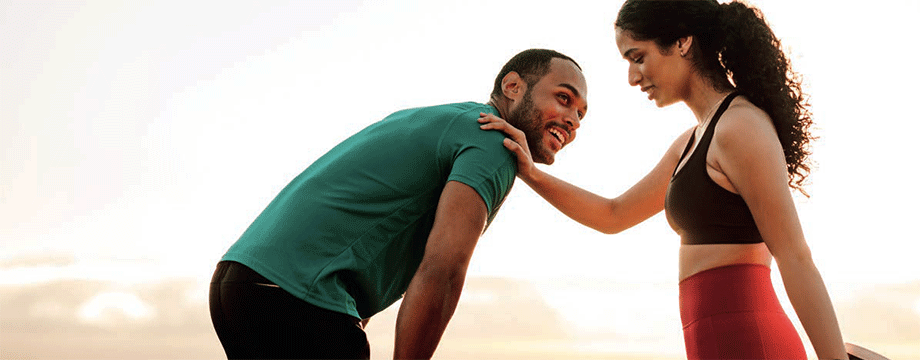Keep on top of your game

Top 10 exercises and nutrition tips for your thirties and forties
As we approach our thirties and forties, our response to fitness undergoes some changes. Although we all vary in our ageing responses, research has shown we may experience a decline in heart rate recovery with age (Lazic et al., 2015), a reduction in muscle power due to a loss of fast-twitch muscle fibres, (Sundberg et al., 2018) a gradual reduction in mobility (Nolan et al., 2009) and, the most well-known, we require more time to recover from exercise (Fell and Williams, 2008).
Here, performance coach Arj Thiruchelvam lists his top 10 recommendations for making your thirties and forties your fittest decades yet.
1 Try a creatine supplement
Take a creatine supplement for muscle and mind. It’s surprisingly under the radar but has significant benefits. By consuming creatine monohydrate, we can:
- increase our muscle mass and strength when training
- improve our anaerobic threshold and recovery
- produce greater total performance
- improve cognitive function and reduce mental fatigue
- aid our response to sleep deprivation
2 Don’t go low fat
You may be tempted to try a low fat diet to drop some weight, but instead just focus on the calories. Fat has some incredibly important benefits including our sex steroid hormone production (including testosterone) that we need for body composition, mood and libido.
3 Do some compound lifts
Choose compound lifts that work multiple muscle groups, such as the bench press, over isolation exercises. These traditional big lifts will stimulate whole body muscle growth, elevate the heart rate and burn more calories but will do it in a fraction of the time, meaning there is no need for you to find 90 minutes to train!
4 Go hill running
There’s a reason why 1980s film training montages included hill runs: they’re really hard, they get you out of breath and they even build muscle and improve power like training weights but, interestingly, they can reduce the chance of injury.
5 Opt for the split squat
The split squat is a more forgiving variant of a squat and a lunge. Split squats demonstrate an action that allows you to achieve good technique with a tall torso and good knee alignment, even if your ankle mobility is poor or you struggle with your hips and lower back. You’ll realise excellent strength and muscle gain from the movement and, if you’re looking to boost your running and sprint speed, this is an excellent choice to incorporate.
6 Practise glute bridges
The glute bridge or hip thrust isn’t just for aesthetics. With the squat, the hip thrust is the most demanding exercise for stimulating the glutes. Those glutes are important for reducing the chance of injury from your back right down to your ankles. Having strong glutes may just reduce the chance of that notorious sports injury, the ACL tear, or lower back muscle strains. Plus, if you’re a keen gym-goer, it works well to boost your one-rep max squat.
7 Try the elbow back press-up
The press-up is a fundamental exercise but many of us develop shoulder inflammation, so try encouraging your elbows backwards during the press-up instead. Make an effort to take a narrower position with the hands and guide the elbows backwards rather than flaring out to promote joint health.
8 Improve your posture
An exercise known as the quadruped t-spine rotation may just help redeem your posture from hours of sitting at a desk. Just 3 x 10 repetitions of this exercise every few days can improve your thoracic mobility (posture) and your ability to twist more freely. There are videos on YouTube that explain how to perform this exercise.
9 Practise pigeon pose
If you experience lower back pain or tight hips, common amongst those who work in an office but also train hard, you must embrace the figure four or pigeon pose into your weekly commitment. It can get you out of a tricky situation if you’re feeling pretty tight and vulnerable. Hold the stretch for 30 seconds, three times on each side, to start making improvements to your mobility and you’ll also notice an improvement in your deadlift.
10 Consume some protein
Consume three to four hits of 0.3 to 0.5g of protein per kg of bodyweight to maximally stimulate ‘muscle protein synthesis’, essentially developing your muscle. Even without training it can maintain
your muscle mass which, as already mentioned, is absolutely vital for health and strength as we become
silver foxes.
Performance Physique founder Arj Thiruchelvam has a BSc Hons in Applied Sports Science from Loughborough University and has co-designed two Sports Science Degrees for Oxford Brookes University. He has 15 years’ experience of performance mentoring, including working as a Sprints & Jumps Coach for UK Athletics. Find out more at www.performancephysique.co.uk
Instagram @Performance_Physique
Twitter @PerformPhysique
Read previous Your Living articles here...
Read articles from our latest issue here...